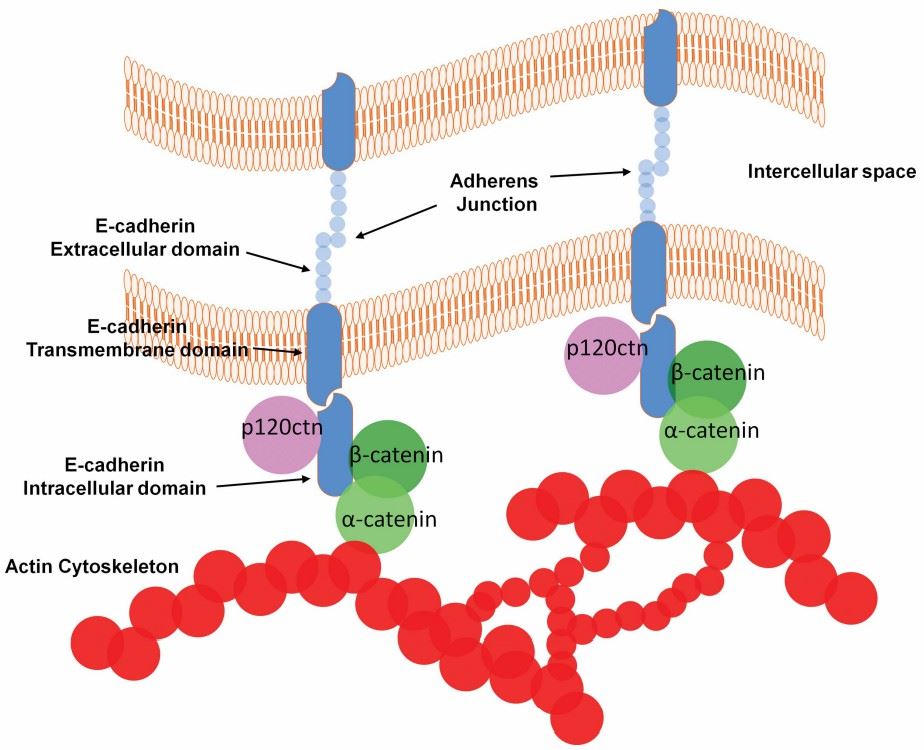What is CDH1 Protein
The CDH1 protein, also known as E-cadherin, is a cornerstone of cellular adhesion and coordinates functions critical for tissue integrity and homeostasis.
CDH1 is a transmembrane glycoprotein that belongs to the cadherin family and functions exclusively as a homophilic cell adhesion molecule. Its main role is to mediate cell-cell adhesion in epithelial tissues, acting as a molecular glue to bind identical molecules on adjacent cells. Structurally, CDH1 contains an extracellular domain responsible for adhesion, a transmembrane domain that anchors it to the cell membrane, and an intracellular domain that is critical for signaling.
 Figure 1. The E-cadherin interface mediating cell-cell adhesion (Gall, T.M., et al. 2013)
Figure 1. The E-cadherin interface mediating cell-cell adhesion (Gall, T.M., et al. 2013)The Function of CDH1 Protein
In addition to its adhesive abilities, CDH1 complexly regulates cellular processes critical to tissue development and maintenance. The protein's ability to form tight junctions between cells is the basis of tissue architecture. CDH1 is also involved in cellular signaling, differentiation, and establishment of tissue polarity. Its role in embryonic development and wound healing emphasizes its importance in coordinating countless cellular functions.
CDH1-Related Diseases
Dysfunction or loss of CDH1 causes a range of diseases, the most important of which is cancer. CDH1 acts as a tumor suppressor and its dysregulation is closely associated with hereditary diffuse gastric cancer (HDGC). Mutations in the CDH1 gene increase the risk of stomach cancer. Furthermore, aberrant CDH1 expression is associated with breast, colorectal, pancreatic, and prostate cancers. Loss of E-cadherin is often associated with increased invasiveness and metastatic potential, highlighting its critical role in curtailing cancer progression.
CDH1 Related Signaling Pathways
The interaction of CDH1 with signaling pathways, especially the Wnt pathway, provides a molecular perspective into its regulatory mechanisms. Under normal conditions, CDH1 maintains the balance of the Wnt pathway by sequestering β-catenin at the cell membrane. However, in the absence or dysfunction of CDH1, β-catenin translocates to the nucleus and activates genes associated with uncontrolled cell proliferation. This dysregulation is a hallmark of various cancers, elucidating the critical role CDH1 plays in regulating cellular signaling cascades.
Applications of CDH1 in Biomedical Research
- Diagnostic Markers
CDH1 expression levels emerge as diagnostic markers for specific cancers. Immunohistochemistry techniques analyze CDH1 expression in tumor tissue, providing valuable insights into the aggressiveness and metastatic potential of cancer. The precision of this diagnostic method helps clinicians develop treatment strategies.
- Therapeutic Target
Dysregulation of CDH1 in cancer opens avenues for targeted therapies. Strategies aimed at restoring or enhancing CDH1 expression have the potential to inhibit tumor progression. Gene therapies and small molecule inhibitors are being explored to modulate CDH1 function, which offers a promising direction for cancer treatment.
- Stem Cell Research
The involvement of CDH1 in maintaining stem cell populations reveals its relevance to regenerative medicine. Insights into how CDH1 affects stem cell differentiation could help develop therapeutic strategies for tissue repair and organ regeneration.
- Drug Development
Targeting signaling pathways associated with CDH1 dysfunction offers prospects for drug development. Small molecules or biologics modulating the Wnt pathway, influenced by CDH1, present opportunities for treating cancers with dysregulated CDH1.
CDH1 plays a key role in complex areas of human biology as a key to cell adhesion and signaling. From its intricate structure to its multifaceted functions and its critical role in disease and biomedical applications, CDH1 reveals a promising frontier in understanding and manipulating cellular processes to facilitate diagnostic and therapeutic advances. As research continues, the potential of CDH1 to shape the future of biomedicine becomes increasingly clear, raising hope in the ongoing pursuit of defeating disease at the molecular level.
Recommended Products for CDH1 Protein
| Cat.# | Species | Product name | Source (Host) | Tag |
|---|---|---|---|---|
| CDH1-274H | Human | Active Recombinant Human CDH1, Fc tagged | HEK293 | Fc |
| CDH1-689H | Human | Recombinant Human CDH1, His tagged | HEK293 | His |
| CDH1-3118H | Human | Recombinant Human CDH1 Protein, MYC/DDK-tagged | HEK293 | Myc/DDK |
| CDH1-2444H | Human | Recombinant Human CDH1 protein, His-tagged | E.coli | His |
| Cdh1-581M | Mouse | Recombinant Mouse Cdh1 protein, His-tagged | E.coli | His |
| Cdh1-4070M | Mouse | Recombinant Mouse Cdh1, His tagged | Human Cell | His |
| Cdh1-7-7477R | Rat | Recombinant Rat Cdh1, His tagged | Human Cell | His |
| Cdh1-583R | Rat | Recombinant Rat Cdh1 protein, His-tagged | E.coli | His |
| CDH1-1739R | Rhesus monkey | Recombinant Rhesus Monkey CDH1 Protein, hIgG4-tagged | HEK293 | hIgG4 |
| CDH1-3324C | Chicken | Recombinant Chicken CDH1 | Mammalian Cell | His |
Reference
- Gall, T.M., Frampton, A.E. Gene of the month: E-cadherin (CDH1). J Clin Pathol. 2013, 66(11): 928-32.

